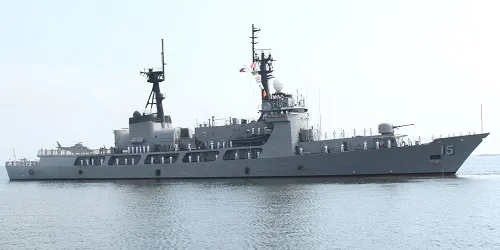-
Cruise Line InformationCarnival Cruise Line Cruising Guide & Tips Alcohol Prices & Selections Unlimited Soda Program Cheers! Beverage Program Deck Plans Dry Dock Schedule Menus Food Recipes Beverage Recipes Secret Decks What's Included? What's Extra?
Norwegian Cruise Line Cruising Guide & Tips Deck Plans What's Included? What's Extra?
Royal Caribbean International Cruising Guide & Tips Food Recipes Beverage Recipes Menus
COVID-19 Cruise Line Bankruptcies -
World's Notable ShipsWorld's Largest Cruise Ships World's Largest Military Ships World's Longest Service Cruise Ships World's Most Recent Cruise Ship Decomms World's Newest Active Cruise Ships World's Oldest Active Cruise Ships World's Oldest Active Military Ships World's Upcoming Cruise Ships COVID-19 Cruise Ship Decommissions
-
Guest RegisterIf you are reading this it means you have not yet registered. Please take a second to REGISTER (it's FREE). You will then be able to enjoy all the features of Cruising Earth.
You should upgrade or use an alternative browser.
BRP Gregorio del Pilar #19 World's Oldest Active Military Ship - Cruising Earth

BRP Gregorio del Pilar - Philippine Navy
#19 World's Oldest Active Military Ship
BRP Gregorio del Pilar is currently ranked #19 in the list of the World's Oldest Active Military Ships.
19
In Service:
1967
(58 Years of Service)Ship StatisticsTrack BRP Gregorio del Pilar
In Service: March 18, 1967
Gross Tonnage: 3,250 GT
Length: 378.00 Feet
Beam: 43.00 Feet
Speed: 29.0 knots / 33.4 mph
Complement: 85
BRP Gregorio del Pilar Historical Brief
Introduction
The BRP Gregorio del Pilar (FF-15) is one of the most prominent and capable ships in the Philippine Navy, with a storied history and significant contributions to the country's maritime defense and security. This historical brief provides an overview of its construction, operational history, notable missions, and its significance within the Philippine Navy.
Construction and Design
The BRP Gregorio del Pilar (FF-15) is a frigate of the Philippine Navy and is the lead ship of its class. Originally commissioned by the United States Navy as the Hamilton-class high endurance cutter USCGC Hamilton (WHEC-715), it was launched on December 18, 1965, by Avondale Shipyards in New Orleans, Louisiana. The ship was named after Commodore Gregorio del Pilar, a hero of the Philippine Revolution and the Philippine-American War.
The ship's design includes a steel hull and is powered by diesel engines, providing both reliability and endurance for extended maritime operations. It is equipped with modern navigation, communication, and surveillance systems, including radar and sonar capabilities, making it well-suited for a variety of naval missions.
Operational History
Transfer to the Philippine Navy
In 2011, the USCGC Hamilton was decommissioned from the United States Coast Guard and subsequently transferred to the Philippine Navy under the Excess Defense Articles (EDA) program. Renamed BRP Gregorio del Pilar (FF-15), the ship underwent refurbishment and modernization to enhance its operational capabilities and integrate it into the Philippine Navy's fleet.
Maritime Security and Law Enforcement
Since its acquisition by the Philippine Navy, the BRP Gregorio del Pilar has been instrumental in enhancing the country's maritime security and law enforcement efforts. The frigate conducts patrols and surveillance operations in Philippine waters, monitoring maritime traffic, preventing illegal activities such as smuggling and piracy, and safeguarding national sovereignty.
Territorial Defense and Naval Exercises
The BRP Gregorio del Pilar plays a crucial role in territorial defense, particularly in the West Philippine Sea (South China Sea) region. It conducts patrols and maintains a presence in disputed maritime areas, asserting Philippine sovereignty and protecting the country's exclusive economic zone (EEZ) and natural resources.
The frigate also participates in joint naval exercises with allied countries, including the United States, Japan, Australia, and regional partners. These exercises enhance interoperability, strengthen maritime security cooperation, and build capacity to address common maritime challenges and threats.
Notable Missions and Operations
Scarborough Shoal Standoff
In 2012, shortly after its transfer to the Philippine Navy, the BRP Gregorio del Pilar was involved in a tense standoff with Chinese maritime vessels at Scarborough Shoal (Panatag Shoal). The standoff highlighted the frigate's role in protecting Philippine interests in disputed waters and asserting maritime rights in accordance with international law.
Humanitarian Assistance and Disaster Response (HADR)
Beyond its security missions, the BRP Gregorio del Pilar has also been deployed for humanitarian assistance and disaster response operations. The frigate provides logistical support, medical assistance, and disaster relief to communities affected by natural disasters such as typhoons and earthquakes, showcasing its versatility and readiness to assist in times of crisis.
ASEAN and Regional Engagements
As part of its regional engagement efforts, the BRP Gregorio del Pilar participates in diplomatic and goodwill visits to neighboring countries and other Southeast Asian nations. These engagements promote cooperation, strengthen diplomatic ties, and contribute to regional stability and security.
Modernization and Upgrades
To enhance its operational capabilities, the BRP Gregorio del Pilar has undergone modernization and upgrades, including improvements to its sensors, communication systems, and armament. These upgrades ensure the frigate remains effective in fulfilling its mission requirements and adapting to evolving maritime threats and challenges.
Legacy and Impact
The BRP Gregorio del Pilar continues to serve as a symbol of Philippine naval capability and sovereignty, embodying the country's commitment to maritime security and defense. Its operational history and contributions underscore the Philippine Navy's role in safeguarding national interests, promoting regional stability, and upholding maritime law in the Asia-Pacific region.
Conclusion
The BRP Gregorio del Pilar (FF-15), originally USCGC Hamilton, represents a cornerstone of the Philippine Navy's fleet, contributing significantly to maritime security, law enforcement, territorial defense, and humanitarian missions. With its robust design, modern capabilities, and strategic deployments, the frigate continues to play a pivotal role in protecting Philippine maritime interests and asserting sovereignty in contested waters. As the Philippines continues to strengthen its naval capabilities, the BRP Gregorio del Pilar remains a vital asset in advancing national security objectives and promoting stability in the region.
Cruising Earth Website Updates
The cruising industry is ever changing. The information contained on this site is updated frequently and kept as accurate as possible. If you believe any of the information is outdated, inaccurate, or you believe you have additional information that could be useful to other cruisers, please post the updated/new information in our Community Forums. Please use this same link to post any questions you may have.

